Related Research Articles

Knut Agathon Wallenberg was a Swedish banker and politician, he was also a Knight of the Order of the Seraphim. Wallenberg was Minister for Foreign Affairs 1914–1917, and member of the Riksdag's Första kammaren 1907–1919. Together with his wife, he created Knut and Alice Wallenberg Foundation, which is one of the main contributors to the private university Stockholm School of Economics. Wallenberg was one of the founders of the Stockholm School of Economics, and is also seen as the founder of the community of Saltsjöbaden and an associated railroad.

Bertil Gustafsson Uggla was a Swedish officer, track and field athlete, modern pentathlete, and fencer.

Gottfrid Larsson was a Swedish sculptor.

Isak Gustaf Alfred Collijn was a Swedish bibliographer and publisher.

Alfhild Valfrid Matilda Palmgren, as married Palmgren Munch-Petersen, was a Swedish educator, linguist, and politician. She reformed Swedish library policy and introduced the public library system in Sweden and Denmark.
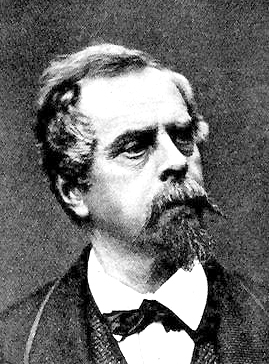
Fritz Ludvig von Dardel was a Swedish diarist, illustrator and early comics artist. He was a courtier, and is known for his diary and illustrations depicting the life of the Swedish court in the mid-19th century.

Johan Axel Gustaf Törneman was one of Sweden's earliest modernist painters. Born in Persberg, Värmland, in Sweden, he grew to work in several modernist styles, was one of the first Swedish expressionist artists, and became a part of the international avant-garde in art after embracing more abstract art styles in Germany and France that were evolving there during the early 1900s. He created his most famous paintings, Night Café I and II, and Trait, in France in 1905. These night café paintings, made from studies in the Place Pigalle, and in other nightclubs popular with artists such as Café du Rat Mort, are seen as two of Swedish modernism's most important works, and are considered breakthrough work of Swedish modernism.
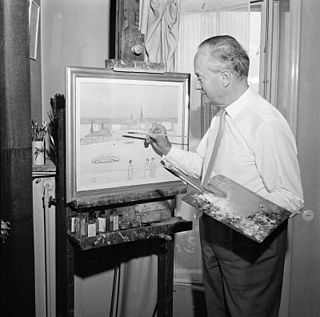
Einar Jolin was a Swedish painter best known for his decorative and slightly naïve Expressionist style. After studying at Konstfack, Stockholm in 1906 and at the Konstnärsförbundets målarskola, Jolin and his friends Isaac Grünewald and Einar Nerman went to Paris for further studies at Henri Matisse's academy from 1908 to 1914.
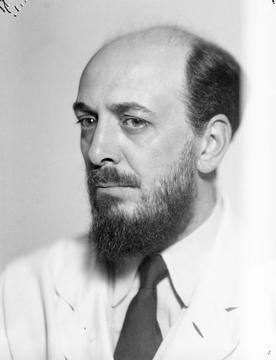
Otto Gustaf Carlsund was a Swedish avant-garde artist and art critic, connected to Cubism, Purism, Neo-Plasticism, and Concrete art.
The Royal Swedish Naval Staff College was a Swedish Navy training establishment between 1898 and 1961, providing courses for naval officers. It was the home of the Swedish Navy's staff college, which provided advanced training for officers. It was located within the Stockholm garrison in Stockholm, Sweden.
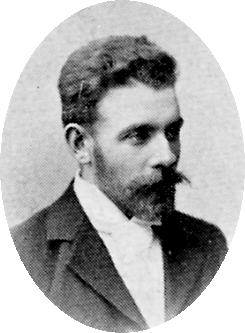
Alfred Maurits Bergström was a Swedish artist and art professor at the Royal Swedish Academy of Fine Arts who worked as a painter, watercolorist and etcher.

Johan Tirén was a Swedish painter who specialized in scenes of the rural life in Northern Sweden.
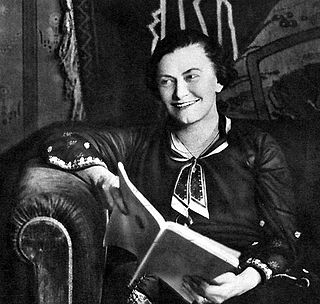
Anna Helena "Lenah" Maria Elgström, born 29 December 1884 in Helsingborg, died 23 December 1968 in Stockholm, was a Swedish author.

General Gustaf Fredrik Oskar Uggla was a senior Swedish Army officer. Uggla had a distinguished military career in Sweden during the late 19th and early 20th centuries. Commissioned in 1863, he rose through the ranks, serving in various capacities, including as a teacher at the Royal Military Academy and as a military attaché in Vienna. Uggla's career highlights include commanding the Royal Military Academy and later the 2nd Army Division. He retired as a general in 1913 but continued contributing to military committees.

The Committee on the Constitution (KU) is a parliamentary committee in the Swedish Riksdag. The committee's responsibilities include examining issues relating to the Swedish Constitution and Administrative laws, as well as examining the Prime Minister's performance of duties and the handling of government matters. The committee's activities are regulated by the Riksdag.

Lieutenant General Herman Georg Waldemar Wrangel was a senior officer in the Swedish Coastal Artillery. He served as commanding officer of the Swedish Coastal Artillery for 15 years (1909–1924). Wrangel served as secretary, member and chairman of a number of committees and commissions. Wrangel was also a member of the Upper House of the Riksdag and a member of the Committee on Defence as well as of the Committee of Supply.

Gerda Henrietta Margareta Planting-Gyllenbåga was a Swedish suffragist and social welfare expert who was deeply engaged in the women's movement at the local and national levels as a member of the Swedish Association for Women's Suffrage (LKPR). She devoted considerable attention to public education, organizing courses to promote women's enlightenment. In 1911, in collaboration with LKPR, she coordinated the nation-wide educational courses funded by Martina Bergman-Österberg. After spending several years in her native Skara, in 1916, she moved to Stockholm as director of CSA, the Swedish social welfare association.

Nelly Anna Charlotta Walden was a Swedish painter, art collector, and writer. A key figure in the activities of Berlin-based avant-garde magazine Der Sturm, Walden was a pioneer of abstract art and was married to German writer Herwarth Walden.
Ultra was an avant-garde bilingual art and literature magazine which appeared in Finland in 1922. Its subtitle was tidskrift för ny konst och litteratur. Although it produced only eight issues, it played a significant role in the introduction of avant-garde literary approach in the region.
References
- 1 2 3 4 Mats Jansson (2013). "Crossing Borders: Modernism in Sweden and the Swedish-Speaking Part of Finland". In Peter Brooke; et al. (eds.). The Oxford Critical and Cultural History of Modernist Magazines. Vol. III. Oxford: Oxford University Press. pp. 666–667. ISBN 9780199659586.
- 1 2 3 Claes-Göran Holmberg (2012). "Flamman". In Hubert van den Berg; et al. (eds.). A Cultural History of the Avant-Garde in the Nordic Countries 1900-1925. Amsterdam; New York: Rodopi. p. 380. doi:10.1163/9789401208918_025. ISBN 978-90-420-3620-8.
- 1 2 3 "Gerda Fredrika Marcus". Svenskt kvinnobiografiskt lexikon .
- ↑ "Thalia:scenisk konst och musik". LIBRIS (in Swedish). Retrieved 2 October 2023.
- 1 2 3 "Detaljer för: Thalia: scenisk konst och musik". uniarts.se (in Swedish). Retrieved 2 October 2023.